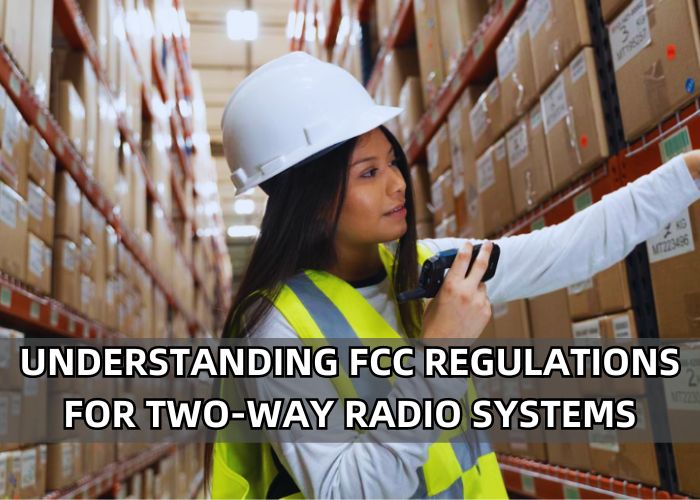As the leading Motorola solutions channel partner serving Central and South Florida, EMCI Wireless specializes in providing the best in communication solutions for both commercial and public safety needs. In this article, we intended to share insights on the often overlooked but critical aspect of FCC regulations pertaining to two-way radio systems.
The Federal Communications Commission (FCC), a governmental agency, mandates that all radio users, regardless of the scale of operations, obtain a license. Despite this requirement, many individuals and organizations remain unaware of the FCC licensing necessities for two-way radios. Whether you utilize a couple or a multitude of radios, FCC licensing is indispensable for all professional and commercial radio systems and devices.
Navigating the Regulatory Landscape of Two-Way Radio Systems
The Federal Communications Commission (FCC) plays an essential role in regulating two-way radio systems across the U.S. As the governing body overseeing telecommunications, the FCC ensures that radio frequencies are allocated efficiently and utilized responsibly.
Explanation of FCC Licensing Requirements
Various sectors require FCC licenses for operating two-way radios, including emergency services, public and private learning institutions, transportation companies, and private security firms. Additionally, licenses are necessary for entities such as summer camps, private daycare facilities, construction sites, private building operations, and healthcare facilities.
The FCC mandates licenses for two-way radios operating on General Mobile Radio Service (GMRS) frequencies. Businesses utilizing Family Radio Service (FRS), Multi-Use Radio Service (MURS), Digital License-Free Radio (DLR), and Digital Trunking Radio (DTR) series radios do not need an FCC license. The power output of the radio, measured in watts, determines whether a license is necessary. Radios below 2 watts can be used without a license, while those above 2 watts require licensing.
Importance of FCC Compliance
Ensuring FCC compliance is crucial for avoiding penalties and maintaining efficient communication systems. Operators of Personal Radio Service stations are subject to penalties for violations of the Communications Act and FCC Rules.
Key points include:
- Penalties for Violations: Violations of the Communications Act may result in fines, imprisonment, or both, upon willful and knowing violations. Subsequent violations may lead to longer imprisonment. Additionally, willful and knowing violations of FCC rules may result in fines of up to $500 per violation or, for continuing violations, $500 per day.
- Forfeiture: Willful or repeated violations of the Communications Act or FCC Rules may lead to forfeiture penalties.
- Cease and Desist Orders: The FCC has the authority to issue cease and desist orders to operators found in violation of the Communications Act or FCC Rules, mandating the immediate cessation of station operations.
Ensuring compliance not only avoids penalties but also contributes to effective and lawful radio communication practices.

Frequency Allocation
Understanding the spectrum bands and their allocation, ranging from VHF to UHF, is foundational. Looking a bit deeper, the choice between narrowband and wideband frequencies significantly impacts data transmission rates. Moreover, selecting the appropriate frequency entails considerations of range, interference, and terrain.
Let’s explore the intricacies of frequency allocation and its significance in optimizing communication reliability and clarity.
Overview of Frequency Bands
Frequency bands are basically the backbone of reliable transmission. From the versatile Very High Frequency (VHF) to the expansive Ultra High Frequency (UHF), understanding these bands is essential.
- VHF and UHF Bands: Radio frequencies, measured in Hertz (Hz), form the backbone of two-way radio communication. Very High Frequency (VHF) bands typically range from 136 to 174 MHz, while Ultra High Frequency (UHF) bands span from 400 to 512 MHz.
- Narrowband vs. Wideband Frequencies: Two-way radio systems operate on either narrowband or wideband frequencies. Narrowband systems facilitate lower data rate transmissions, while wideband systems support higher data rate transmissions, enabling faster communication.
Importance of Selecting Appropriate Frequencies
Two-way radio operators should consider the following factors when choosing frequencies:
- Range: The distance over which the signal can effectively transmit.
- Interference: Potential disruption caused by other radio transmissions or electronic devices.
- Terrain: Environmental factors such as buildings, mountains, and foliage affecting signal propagation.
Ensuring compliance with frequency regulations is crucial to avoid interference and ensure clear communication. Radio Frequency (RF) interference, caused by transmitters on similar frequencies, can disrupt communication. Public safety radio systems, like those used by emergency services, often operate within specific frequency bands, such as the 800 MHz band (806-824 MHz and 851-869 MHz).
According to the International Telecommunication Union’s (ITU) Radio Regulations, RF interference is classified into three types:
- Permissible Interference: Interference that complies with established quantitative criteria.
- Accepted Interference: Interference agreed upon by multiple administrations.
- Harmful Interference: Interference that endangers the functioning of radio navigation or safety services.
Harmful interference can originate from intentional sources like illegal jamming devices or unintentional sources such as low-quality electronics or improperly installed signal boosters. It’s essential to mitigate these sources to ensure uninterrupted communication and compliance with regulations.
Using two-way radios responsibly is imperative for maintaining effective communication channels and ensuring public safety. Any malicious interference can disrupt vital transmissions, potentially endangering lives and compromising critical operations. The Communications Act of 1934, a legislation governing telecommunications in the U.S, outlines stringent regulations to prevent such interference and uphold the integrity of radio communications.
Key provisions include:
- Section 301: Mandates licensing or authorization for radio transmitter operation.
- Section 302(b): Prohibits the manufacture, importation, and use of signal jammers.
- Section 333: Criminalizes willful or malicious interference with licensed radio communications.
- Section 501: Imposes substantial fines and criminal sanctions for violations.
- Section 503: Allows the FCC to impose forfeitures for violations of the Act or FCC regulations.
- Section 510: Provides for the seizure of unlawful equipment.
Adhering to these regulations is essential for maintaining the integrity of communication systems and ensuring compliance with the law.

Responsible Use of Two-Way Radio Systems
Responsible utilization of two-way radio systems is a must to maintain operational integrity and uphold legal compliance.
Let’s explore key practices and guidelines that organizations should adhere to for responsible use:
- Frequency Management: Regularly monitor and manage frequency channels to prevent interference and ensure efficient communication.
- License Compliance: Obtain necessary licenses and authorizations for operating radio transmitters, as mandated by the Communications Act of 1934.
- Prohibited Devices: Avoid the manufacture, importation, or use of signal jammers within the U.S., as outlined in Section 302(b) of the Act.
- Interference Prevention: Refrain from willful or malicious interference with licensed radio communications, as prohibited by Section 333 of the Communications Act.
- Adherence to Regulations: Comply with all provisions of the Communications Act, including Section 501, which imposes monetary fines and criminal sanctions for violations.
- FCC Guidelines: Familiarize yourself with FCC regulations and guidelines to ensure adherence to regulatory standards.
- Training and Education: Provide comprehensive training to personnel on the proper use of two-way radio systems and compliance with communication regulations.
- Monitoring and Enforcement: Implement measures to monitor radio transmissions and enforce compliance within the organization.
By adhering to these principles of responsible use, organizations can mitigate risks, enhance operational efficiency, and contribute to a safe and reliable communication environment.
EMCI Wireless Can Help You Obtain Your FCC Licenses
Understanding and adhering to FCC regulations are vital for navigating the complex landscape of two-way radio systems. We’ve explored key aspects such as FCC licensing requirements, frequency allocation, and responsible use practices. Having an FCC license will ensure your frequencies do not overlap with anyone else. Paying a small fee for a license is far less compared to the complaints and fees you might receive if you go unlicensed.
EMCI Wireless is here to assist you in obtaining or renewing your FCC license, ensuring compliance and uninterrupted communication for your organization. Remember, FCC licenses typically remain valid for 10 years, and EMCI Wireless can verify the expiration date of your existing license. Contact us today to streamline your licensing process and optimize your communication infrastructure.






